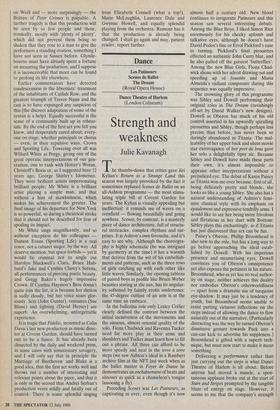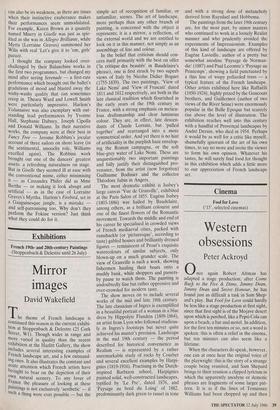Dance
Les Patineurs Scenes de Ballet The Dream (Royal Opera House)
Strength and weakness
Julie Kavanagh
The thumbs-down that critics gave Jiri Kylian's Return to a Strange Land this season was largely provoked by the fact it sometimes replaced Scenes de Ballet on an all-Ashton programme — the most stimu- lating triple bill at Covent Garden for years. The Kylian is visually appealing but ineffectual: it reminds me of waves on a cornfield — flowing beautifully and going nowhere. Scenes, by contrast, is a masterly piece of dance architecture, full of structu- ral intricacies, complex rhythms and sur- prises. It is Ashton's own favourite, and it's easy to see why. Although the choreogra- phy is highly schematic (he was intrigued by geometry at the time) it has a warmth that derives from the wit of his embellish- ments and patterns, such as the three rows of girls catching up with each other like little waves. Similarly, the opening tableau of paired boys in profile like Bruce Weber beauties staring at the sun, has its angular- ity softened by faintly erotic undertones: the 45-degree outline of an arm is at the same time an embrace.
In the ballerina role only Lesley Collier clearly defined the contrast between the initial incisiveness of the movements and the sinuous, almost oriental quality of the solo. Fiona Chadwick and Ravenna Tucker need far more play in their arms and shoulders and Tucker must learn how to fill out a phrase. All three can afford to be more speedy and neat in the terre a terre steps (we saw Ashton's ideal in a Rambert archive film at the NFT last week when as the ballet master in Foyer de Danse he demonstrates an enchainement of beats and sissones as quick as a chameleon's tongue lassooing a fly).
Preceding Scenes was Les Patineurs, as captivating as ever, even though it's now almost half a century old. New blood continues to invigorate Patineurs and this season saw several interesting debuts. Among the Blue Boys, I liked Simon Rice enormously for his cheeky aplomb and talkative eyes, although he doesn't have David Peden's line or Errol Pickford's ease in turning. Pickford's final pirouettes effected an authentic John Curry blur, and he also pulled off the gutsiest 'butterflies'. Among the new Blue Girls, Fiona Chad- wick shone with her adroit drawing out and speeding up of fouettes and Maria Almeida's radiant composure during this sequence was equally impressive.
The crowning glory of this programme was Sibley and Dowell performing their original roles in The Dream (ravishingly off-set by David Walker's new designs). Dowell as Oberon has much of his old control asserted in his upwardly spiralling pirouettes and Sibley, though perhaps less precise, than before, has never been so daringly abandoned as Titania. The mal- leability of her upper back and silent movie star extravagance of her port de bras gave her solo a delightfully tipsy air. Because Sibley and Dowell have made these parts their own, it's almost impossible to appraise other interpretations without a prejudiced eye. The debut of Karen Paisey as Titania won me over because, first of all, being delicately pretty and blonde, she looks so like a young Sibley. She also has a natural understanding of Ashton's femi- nine classical style with its emphasis on epaulement and expressive tendrilly arms. 1 would like to see her being more frivolous and flirtatious in her duet with Bottom: Sibley plays this enchantingly, as if Titania has just discovered that sex can be fun.
Paisey's Oberon, Phillip Broomhead is also new to the role, but has a long way to go before approaching the ideal estab- lished by Dowell. With his imperious presence and mesmerising eyes, Dowell convinces you of Oberon's omnipotence yet also exposes the pettiness in his nature. Broomhead, who as yet has no real author- ity on stage, neither achieves this duality nor embodies Oberon's otherworldliness — apart from a dramatic use of turquoise eye-shadow. It may just be a tendency of youth, but Broomhead seems unable to resist putting virtuoso inflections on the steps instead of allowing the dance to flow naturally out of the narrative. (Particularly distracting was the way he turned Oberon's dismissive gesture towards Puck into a can-can kick to advertise his suppleness.) Broomhead is gifted with a superb tech- nique, but must now start to make it mean something.
Delivering a performance rather than just carrying out the steps is what Dance Theatre of Harlem is all about. Before anyone had moved a muscle, a spon- taneous applause broke out at the start of Stars and Stripes prompted by the tangible blaze of energy on stage. However, it seems to me that the company's strength can also be its weakness, as there are times when their instinctive exuberance makes their performances seem unmodulated. For example, Karen Brown as a quaintly named Misery in Giselle was just as spir- itied as she was in Allegro Brilliante, while Myrta (Lorraine Graves) summoned her Wilis with real 'Let's give it to 'em, girls' pazazz.
I thought the company looked over- challenged by their Balanchine works in the first two programmes, but changed my mind after seeing Serenade — a first-rate performance which brought out the ballet's gradations of mood and blasted away the wishy-washy quality that can sometimes creep in. Theara Ward and Lowell Smith were particularly impressive. Harlem's Voluntaires was also exemplary with out- standing lead performances by Yvonne Hall, Stephanie Dabney, Joseph Cipolla and Donald Williams. In their narrative works, the company were at their best in Fancy Free — Jerome Robbins's jocular account of three sailors on shore leave (in the sentimental, smoochy role, Williams excelled again). The Robbins work brought out one of the dancers' greatest assets: a refreshing naturalness on stage. But in Giselle they seemed ill at ease with the conventional mime, either minimising it — as Cassandra Phifer did as Mme Berthe — or making it look abrupt and artificial — as in the case of Lorraine Graves's Myrtha. Harlem's Firebird, set in a Gauguinesque jungle, is a mistake and self-patronising too. Why don't they perform the Fokine version? Just think What they could do for it.



















































 Previous page
Previous page